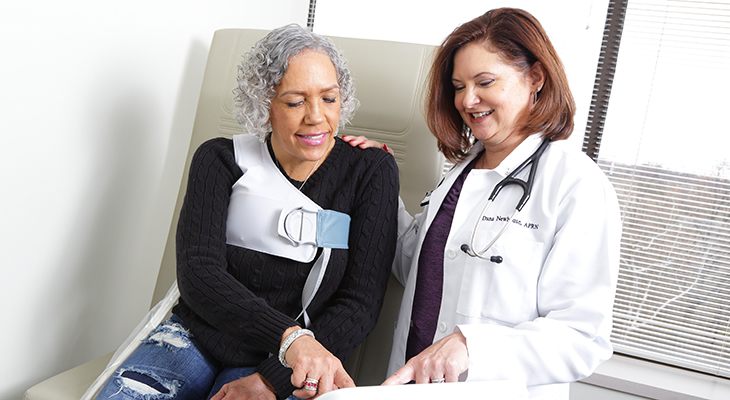
Innovative technology allows providers with the Norton Heart & Vascular Institute Advanced Heart Failure and Recovery Program to see changes in patients’ conditions in real time, adjust their medications and diet as needed, and schedule clinical visits when necessary.
We’re using technology to help patients’ hearts recover so they will not need advanced therapy, with the overall goal of improving their quality of life and heart function while
preventing hospital readmission.
Chief among our new technologies at the Advanced Heart Failure and Recovery Program are the CardioMEMS HF System, the LifeVest and the ReDS System.
CardioMEMS HF System
The CardioMEMS HF System is a permanently implanted device that transmits distal pulmonary artery readings, giving us very accurate internal data from a patient at home.
The device is implanted in a right heart catheterization outpatient procedure. Once in place, the battery-free sensor measures heart rate as well as systolic, diastolic and mean pulmonary artery pressures. In a sense, this technology offers real-time hemodynamics.
To capture the data, the patient with the implanted CardioMEMS device lies on a special pillow for a few seconds each day. The pillow receives a signal from the device and transmits the readings to the Advanced Heart Failure and Recovery Program team.
Pulmonary artery pressure is a proxy for fluid retention in the lungs. If there’s a rise in pressure, the team reaches out to patients before they become more symptomatic or are even aware of fluid accumulation. It’s a good way of keeping track of someone’s fluid and keeping them out of the hospital.
Most of the management is done on the phone. If I see a rise in pressure, I will call the patient to see what’s going on, talk about diet and make sure they haven’t missed a medication.
I might ask the patient to take an additional dose of water pills or make another adjustment to the medications. Typically, the patient readings are monitored a couple of times per week, but if the CardioMEMS readings go beyond the parameters set at the time of implant, I’ll be alerted by email and reach out to the patient immediately.
LifeVest
LifeVest is a wearable cardioverter defibrillator used by patients newly diagnosed with systolic heart failure, who are at risk of sudden cardiac death. The vest, worn directly against the skin, detects when the heart has gone into a life-threatening, rapid rhythm, and shocks the heart back into a normal beat.
The LifeVest also can be used to monitor a patient’s heart rate during a six-minute walk test and to help track myocardial recovery.
The Advanced Heart Failure and Recovery Program team uses data from the LifeVest to guide treatment. LifeVest gives us a complete picture. We can see the patient’s heart rhythm at any point in time. If data from the LifeVest shows an elevated heart rate, we can increase the patient’s beta blocker dosage to bring the heart rate down. We can see how active the patient is, how many steps per day they’re taking, which is an indication of how they’re feeling. We can even see what position the patient is in while lying down. If the patient’s activity level is declining and the body angle during sleep is going up, we know they’re not doing well, and we can bring them in to see the team.
ReDS System
Unlike the CardioMEMS device and LifeVest, the ReDS System is used in a clinical setting. The wearable vest uses radar technology to measure fluid in the right lung. In 90 seconds, the external device tells us what percentage of fluids a patient has.
The ReDS System vest doesn’t replace a physical exam, but provides an additional vital sign record. We use it in our clinic when we’re seeing a patient for the first time or when we’re looking for further data. We also use it when a patient comes in for a follow-up visit after being hospitalized. If the patient still has too much fluid, he or she can receive an IV diuretic in the office.
Previously, doctors gauged fluid in the lungs by listening with a stethoscope for noises in the lungs, or relying on implantable devices, weight measurements and chest X-rays. The combination of these three innovative technologies is giving us faster, less invasive and more accurate insights on each patient so we can make adjustments in real time.
Refer a Patient
To refer a patient to Norton Heart & Vascular Institute Advanced Heart Failure and Recovery Program, use our online form and select “Cardiology-Heart Failure.”

